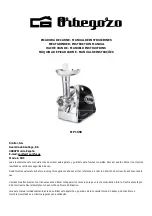
ENGLISH
18
18
Kickback and related warnings
- Kickback is a sudden reaction to a pinched or snagged
rotating wheel, backing pad, brush or any other acce
sory. Pinching or snagging causes rapid stalling of the
rotating accessory which in turn causes the uncontr
lled power tool to be forced in the direction opposite
of the accessory’s rotation at the point of the binding.
For example, if an abrasive wheel is snagged or
pinched by the workpiece, the edge of the wheel that
is entering into the pinch point can dig into the surface
of the material causing the wheel to climb out or kick
out. The wheel may either jump toward or away from
the operator, depending on direction of the wheel’s
movement at the point of pinching. Abrasive wheels
may also break under these conditions.
Kickback is the result of power tool misuse and/or
incorrect operating procedures or conditions and can
be avoided by taking proper pr ca tions as given below.
-
Maintain a firm grip on the power tool and position
your body and arm to allow you to resist kickback
forces.
The operator can control kickback forces, if
proper pr cautions are taken.
-
Use special care when working corners, sharp
edges, etc. Avoid bouncing and snagging the
accessory.
Corners, sharp edges or bouncing have
a tendency to snag the rotating accessory and cause
loss of control or kickback.
-
Do not attach a thin toothed saw blade.
Such blades
create frequent kickback and loss of control.
-
Always feed the bit into the material in the same
direction as the cutting edge is exiting from the
material (which is the same direction as the chips
are thrown).
Feeding the tool in the wrong direction
causes the cutting edge of the bit to climb out of the
work and pull the tool in the direction of this feed.
-
When using cut-off wheels, high-speed cutters
or tungsten carbide cutters, always have the
work securely clamped.
These wheels will grab if
they become sligh ly canted in the groove, and can
kickback. When a cut off wheel grabs, the wheel itself
usually breaks. When the steel saw, high-speed cutters
or tungsten carbide cutter grab, it may jump from the
groove and you could lose control of the tool.
Additional safety instructions for grinding.
-
Use only wheel types that are recommended
for your power tool and only for recommended
applications. For example: do not grind with the
side of a cut-off wheel.
Abrasive cut-off wheels are
intended for peripheral grinding, side forces applied to
these wheels may cause them to shatter.
-
For threaded abrasive cones and plugs use only
und maged wheel mandrels with an unrelieved
shoulder flange that are of correct size and length.
Proper mandrels will reduce the possibility of breakage.
-
Do not “jam” the cut-off wheel or apply excessive
press re. Do not attempt to make an excessive
depth of cut.
Overstressing the wheel increases the
loading and susceptibility to twisting or binding of the
wheel in the cut and the possibility of kickback or wheel
breakage.
-
Do not position your hand in line with and behind
the rotating wheel.
When the wheel, at the point of
operation, is moving away from your hand, the possible
kickback may propel the spinning wheel and the power
tool directly at you.
-
When wheel is binding or when interrupting a cut
for any reason, switch off the power tool and hold
the power tool motionless until the wheel comes to
a complete stop. Never attempt to remove the cut-
off wheel from the cut while the wheel is in motion
otherwise kickback may occur.
Investigate and
take corrective action to eliminate the cause of wheel
binding.
-
Do not restart the cutting operation in the workpiece.
Let the wheel reach full speed and carefully re-enter
the cut.
The wheel may bind, walk up or kickback if the
power tool is restarted in the workpiece.
-
Support panels or any oversized workpiece to
minimize the risk of wheel pinching and kickback.
Large workpi ces tend to sag under their own weight.
Supports must be placed under the workpiece near the
line of cut and near the edge of the workpiece on both
sides of the wheel.
-
Use extra caution when making a “pocket cut” into
exi ting walls or other blind areas.
The protruding
wheel may cut gas or water pipes, electrical wiring or
objects that can cause kickback.
Safety warnings specific for polishing operations
-
Do not allow any loose portion of the polishing
bonnet or its attachment strings to spin freely.
Tuck away or trim any loose attachment strings.
Loose and spinning attachment strings can entangle
your fingers or snag on the workpiece.
Safety warnings specific for wire brushing operations
-
Be aware that wire bristles are thrown by the brush
even during ordinary operation. Do not overstress
the wires by applying excessive load to the brush.
The wire bristles can easily penetrate light clothing
and/or skin.
-
Allow brushes to run at operating speed for at least
one minute before using them.
During this time no
one is to stand in front or in line with the brush.
Loose bristles or wires will be discharged during the
run-in time.
-
Direct the discharge of the spinning wire brush
away from you.
Small particles and tiny wire fragments
may be discharged at high velocity during the use of
these brushes and may become imbedded in your skin.
Summary of Contents for SD150B
Page 2: ......
Page 3: ...13 6 7 8 9 11 10 12 13 1 2 3 4 5 11 10 ...
Page 54: ...NOTAS 54 ...
Page 55: ...NOTAS 55 ...
















































